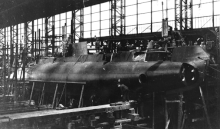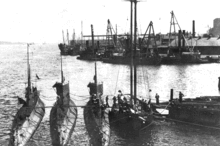This article needs additional citations for verification. (April 2008) |

| |
| Class overview | |
|---|---|
| Operators | |
| Preceded by | |
| Succeeded by |
|
| In commission | 1915–1945 |
| Completed | 42 |
| Lost | 9 |
| Retired | 33 |
| General characteristics | |
| Type | Submarine |
| Displacement | |
| Length |
|
| Beam | 15 ft 4 in (4.67 m) |
| Installed power |
|
| Propulsion | 2 × propeller shafts |
| Speed | |
| Range |
|
| Complement | 22 |
| Armament |
|



The British H-class submarines were Holland 602 type submarines used by the Royal Navy. The submarines constructed for the British Royal Navy between 1915 and 1919 were designed and built in response to German boats which mined British waters and sank coastal shipping with ease owing to their small size. The H class was created to perform similar operations in German waters, and to attack German submarines operating in British waters.
Despite their cramped size and lack of a deck gun on some submarines, the class was popular amongst submariners, and saw action all around the British Isles, some being transferred as far as the Adriatic. Owing to the late arrival of most of the class, they were unable to have much impact in service, only destroying two German submarines U-51 and UB-52 for the loss of four of their own number.
Post-war, many were retained in the Royal Navy for training purposes, while four more were lost in accidents during the 1920s. At the outbreak of the Second World War, the class was obsolete, but retained in training and coastal warfare roles to help the Royal Navy cope with heavy losses to the submarine fleet during the early stages of the war. Two were sunk in this role by German countermeasures. The Canada-built boats were equipped with Fessenden transducers, which were missing from the US-built boats.